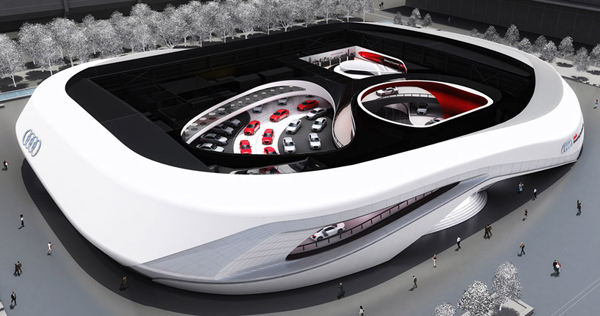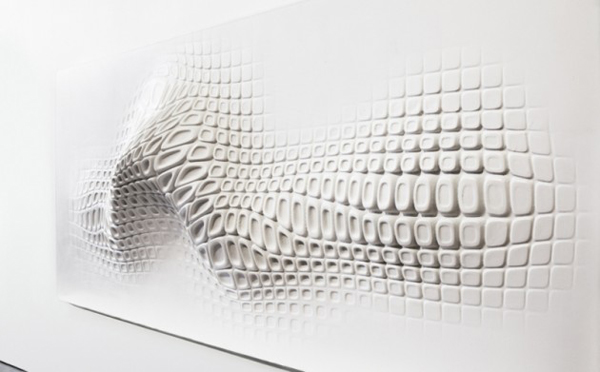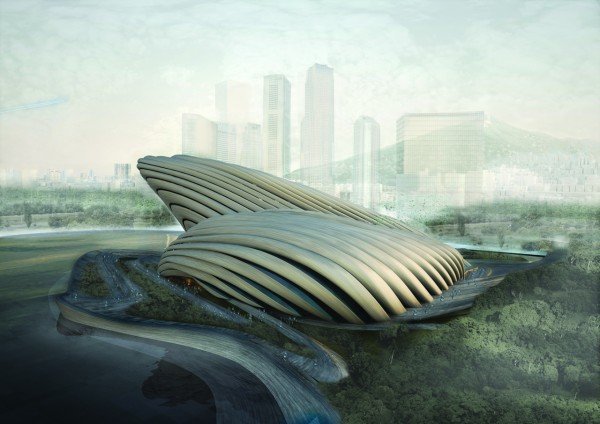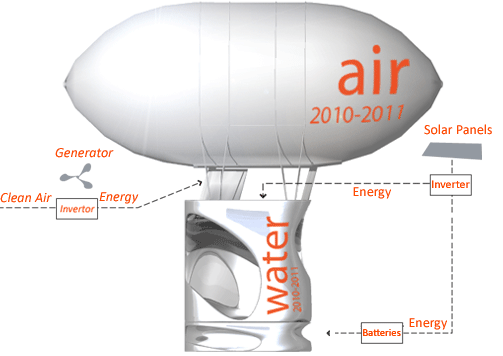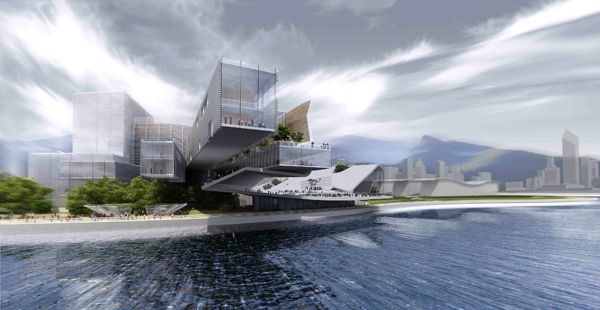The project is a temporary building, part of the upcoming Frankfurt Motor Show. It is designed by Schmidhuber + Partner and will remain in place until October 20, 2011, to house the Frankfurt Book Fair. The Audi Ring is 100 meters long, 70 meters wide and 12 meters high. The exhibition in the Grand Hall leads visitors through the vehicle presentation, followed by a technology park with various interactive exhibits. .The 400 meter-long test track extends across both levels of the interior, visible from the exterior via cutaways along the structure’s sides and top, and permitting the travel of up to nine vehicles at once. The course is open for visitors to experience by riding as passengers alongside professional drivers in a range of current and future Audi vehicles. As co-drivers, visitors are immersed in the driving experience, provided by the combination of technology and architecture. Read the rest of this entry »
Audi Ring for Frankfurt Motor Show 2011 / Schmidhuber + Partner
Nympha Cultural Center for future Bucharest / upgrade.studio
Nympha Cultural Center in Bucharest is a concept proposal designed by Brasov-based upgrade.studio, an architectural practice oriented towards computational design and cutting-edge concepts. Their Urban BY-PASS project received a Special Mention at eVolo’s Scyscraper Competition in 2008.
The proposal is conceived as a programmatic addition to the studio’s Digital University project. It comprises Art galleries, Cultural Center, Performing Arts Center and the University library.The two morphologies seem to be deliberately conflicted, expressing opposite approaches. Read the rest of this entry »
The hidden Art of Sneakers / Ora-ïto
The natural acrylic stone material HI-MACS® was chosen by eminent French artist Ora-ïto for his entry into the recent Wallpaper/Reebok exhibition in London. Fabricated by Candido Hermida in Spain, HI-MACS® was selected for its outstanding properties, visual and tactile effects and the ability to offer the artist thermoforming capabilities that placed zero restriction on his vision and ability to create a stunning three-dimensional creation.
Five of the world’s leading creative artists were invited to participate and Ora-Ito’s contribution was an interpretation of the Reebok RealFlex shoe in the form of a wall-mounted installation made entirely from HI-MACS®.
The detail of Ora-Ito’s work was what he described as the “iconic sneaker soles”. In creating this by using HI-MACS® the designer was able to exercise various sculptural experiments taking inspiration from the RealFlex sole’s “hidden art” aspects, resulting in a topographic landscape made to touch and explore its own poetic qualities. Read the rest of this entry »
London Olympic Pavilion X / James Law Cybertecture
To honour London’s imminent hosting of the 2012 Olympic games, James Law Cybertecture has presented an Olympic Pavilion X design to offer a statement of passion and excellence whilst providing a thrilling platform for memorable celebrations by the city and its citizens.
Inspired by the fluid shape of a raindrop splash, Olympic Pavilion X becomes a modern iconic landmark to inject both fun and flair to the monumental Trafalgar Square. With an electrifying exterior façade stretching 375 square meters, Olympic Pavilion X offers functional features of information center, souvenir shop and administration office at the tip of its three separate corners. Read the rest of this entry »
Artic Mass-Painting / Emergent
This proposal by Emergent is based on creating a complex visual oscillation between two and three dimensional realms. Somewhere between the disciplines of sculpture and painting, the piece registers as a mass but also as a graphic. Loopy, spotted patterns flow over manifold surfaces, simultaneously dissolving the mass and re-establishing it. Transparent zones allow people to view deep inside the object, their gaze pulled into involutions in interior surfaces. They can see the inside of the mass-painting.
The human brain, recent neuroscience suggests, is not engaged in “seeing” space, but in actively “modeling” space1. Residing on multiple ontological levels, this project is an attempt to force the brain to hedge and guess in its “modeling” of physical reality.
The colorful pattern language, while fanciful at first glance, is not simply a visual phenomenon. It is the result of intersecting a map of structural stresses with a painterly sensibility. The loopy mass is analyzed as a composite shell structure, revealing areas of low and high stress. The resultant color-gradient map is manipulated to produce certain visual effects but also broken down into layers of variable thickness and material strength. Color and pattern therefore only partially index material forces; the piece exceeds simple material expression towards something which correlates nature and culture. Read the rest of this entry »
Anisotropia: A Frozen Piece of Music – Busan Opera House / Orproject
Anisotropia, the design for the new Busan Opera House by Orproject is based on Klavierstück I, a composition for piano by Orproject director Christoph Klemmt. It is based on a twelve tone row which is repeated and altered by the different voices, in order to create complex rhythmic patterns.
Anisotropia becomes the physical manifestation of Klavierstück I, a frozen piece of music. The design for the Busan Opera House is based on a simple strip morphology instead of a twelve tone row, which creates the facade, structure and rhythm within itself, its repetition happening in space instead of time. Layers of the strips form the façade structure, and the shifting and alteration of these patterns results in the formation of complex architectural rhythms which are used to control the light, view and shading properties of the façade.
Klavierstück I uses a twelve tone row which starts with the lowest key of the piano. After its first cycle the row gets repeated, though shifted up by a halftone. However rather than translating up every tone by a halftone, only the lowest tone of the row is translated up by one octave. Like this the row remains the same, but its range has been shifted. Read the rest of this entry »
Hybrid Diamantenbörse is a Voronoi installation in Frankfurt
The project was designed by a team organized by Prof. Dr. Markus Holzbach at the Offenbach Academy of Art and Design. The parametric engineer for the project was Xing Wang. The design was exhibited in Frankfurt in January 2011 and it explores the structure andcombinations of cellular geometries, completely relying on computational design.
The project’s aim was to build a pavilion inside Diamantenbörse in Frankfurt. It was based on mobius geometry with 3d voronoi pattern structure. It tried to integrate special light effects for the media show during the exhibition. The 3d vronoi pattern structure is manufactured as straight wood panels by 5 axis milling machine and assembled on site. In order to save time and material, most parts of the wood panels were cut under 3 axis cutting method, only the both ends parts of the panels with slope are cut through 5 axis setting. Read the rest of this entry »
Proposal for Busan’s Opera House Articulates the Existing Topography / OODA
OODA’s scheme for the Busan Opera House engages with the natural topography, articulating a multi levelled building and integrating the different cultural activities and program seamlessly. The dominant flow circulation, flexibility and concept strategy enables full accessibility.
The design concept creates spaces that blur the difference between building and landscape, intensifying the fluidity between interior and exterior spaces, indoor and outdoor venues. The formal approach is driven from the natural proportion of the program merged with inspirational themes (like sea shells – music – and butterfly typical pacific fish) that allows the building to assume its own unique charm and identity. The formal image with its vibrant and meaningful presence helps to create a brand new-age landmark for South Korea as a strong symbolic voice to the world.
Iconic shell sound towards the sea
The Opera Auditorium has a pioneering and innovative design concept, it is as flexible and efficient as it is elegantly sculpted. The center area can rotate around itself so in the same space it is possible to have an Opera with all its requirements, but also some more intimate concert and a centered stage venue allowing to have audience all around. Read the rest of this entry »
Water Capsule Concept: A Fantastical Dream-Like Living Vessel for Global Flooding
The interest of creating this project was to provoke opposing forces of beauty and darkness – the idea of immersing survivors into their environment of global flooding through an elegant and energetic fusion of floating architecture.
The project has the appearance of a glamorous water cube emerging from billowing cloudscapes to flood location by a hot air dirigible. The Water Capsule is a simple form constructed of highly engineered, gleaming white fiberglass-reinforced panels. The structure folds into a sequence of spaces illuminated by two skylights and a window to the sea below. The project’s overall organization follows the drift of its curving form floating experientially through air and water giving freedom to “one’s” imagination from their loss. Read the rest of this entry »
Cantilevered Volumes Define a New Opera House for Busan
The outstanding natural environment: the sea and the mountains are features that are reflected in this project by Ayrat Khusnutdinov, and Alexey Bychkov/ADM. These natural features, not architecture, are the prime actors in the scene; here the architecture is just a frame.
The notion that a building can be a musical instrument itself being a magnet of public activity is one of the steering wheels of the proposal. The undulating structure behaves like a ballet dancer creating different scenic effects, closing the space and opening it in its climax on the shoreline. Its dramatic pleats are synonymous with behavior of the stormy sea and crescendos of opera music. Read the rest of this entry »

